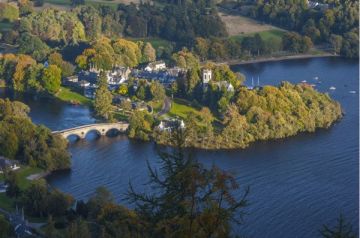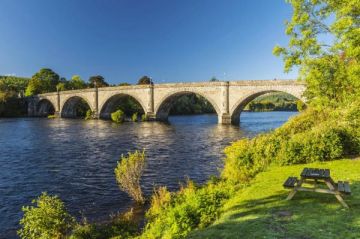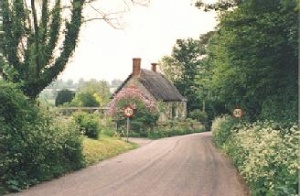
by Joanne Paul
Surely when Tess of the d'Urbervilles stopped in Evershot (Hardy's Evershead) on her way to Beaminster (Emmenster) it couldn't have looked much different than it does today.
It had a school, a doctor's surgery, raised pavements, and shops with bow fronts built onto much older house faces of grey limestone, just as it has now. The cottage she slept overnight in is still there and so is the Acorn Inn. I wonder what she thought when she first walked into the village. She was probably too tired to be impressed.
When I first saw Evershot I was very impressed with this village of 300 snuggled into the folds and coombes of the Dorset landscape. It seemed to represent rural England at its very best. Of course, I had no reason to be as tired as poor Tess. I had arrived by means of modern transportation. Not by automobile or train but by country bus . . . I can see some of you wrinkling up your noses . . . spend a holiday on the buses? ... never!
At home in L.A., I would never ride the buses for fun. But in the English countryside I had a ball. I fell in love with the buses and their drivers. I didn't ride during rush hours so they were usually half empty and I could spread out and move about changing from one side to the other for the better view - and it was always an over the hedge or over the wall view, much better than when riding in a car, and I never had to worry about an intimidating road map. Most of the other passengers seemed to know each other and called the driver by name. Sometimes they were kind enough to include me in their chat.
When the bus arrived in Evershot it stopped right in front of the school and across the street from my guest house. The trip from Dorchester had taken about 40 minutes, passing through the pretty villages of Charminster, Frampton, Maiden Newton, Cattistock, Rampisham, and Bennville Bridge.
My plan was to spend my whole six weeks vacation in Dorset travelling on inexpensive country buses. I was taking Thomas Hardy's advice. He held that "it is better to know a little bit of the world remarkably well than to know a great part remarkably little." It was lovely to save the money but the real reason I was using the buses was that I was too chicken to drive in England. The roundabouts and the wrong side of the road terrified me. I was very cautious at first and boarded my first bus very gingerly, but, before long I became fully converted to the joys of bussing, the freedom and relaxation were irresistible.
Before leaving home I had written to the Tourist Information Centre in Dorchester. They sent: The West Dorset Holiday Accommodation Register, Bus Timetables of Independent Operators, Southern National's Timetable, The Official Dorset Town Guide, and other Dorset literature. I wrote to Gulliver's Bookshop in Wimborne Minster asking if they had any books about Dorset villages. They obliged by sending Dorset Villages by Roland Gant, and The Dorset Village Book by Harry Ashley.
It was a simple matter, and great fun, to read about the villages in the books, pick the ones I most wanted to see, and then pick the bus timetables to see which ones could easily be reached. I was delighted to find that almost every village was listed at least once, usually several times. I then wrote to several guest houses in the areas I wanted to visit, making the reservations at the places that sounded most appealing.
In Evershot I could have stayed at the Summer Lodge, Holywell House, Rectory House, or the Acorn Inn. My letter from Chris Walford at the Rectory House was so warm and friendly that I decided to stay there. Chris was standing outside her house when my bus pulled up and came to greet me as I crossed the street.
My three day stay in Evershot was hardly long enough to enjoy all it had to offer. I spent my first afternoon exploring and found a pathway behind the church that led to St. John's Well and the spring that eventually becomes the Dorset Frome. Chris told me that there are over 20 miles of lovely footpaths within a two-mile radius. Several pass right through the 5000 acre Melbury Estate, so on my second day I decided to walk through the estate to the village of Melbury Osmund on the other side. She told me it would take about two hours and assured me there was a pub near the village where I could rest and get a bite to eat before making the return journey.
This walk has to be one of the most enchanting in all of England. Soon after passing through the Melbury Gate, with its two 1690 lions that look more like benign pussy cats sitting on top of their piers, I came to a leafy green meadow devoted to the purebred horses that belong to Lady Teresa Agnew who lives at Melbury House. Several of the beautiful creatures had newborn colts at their side and they looked at me inquiringly as I walked on toward the manor house of golden grey stone standing on its ridge of cornbrash limestone.
Editor's note:
Melbury now belongs to Lady Charlotte Townsend, daughter of Lady Teresa Agnew.
It is dominated by a lofty hexagonal tower built during Tudor times for viewing the park and the deer. As I walked on I caught my first glimpse of deer just as I entered a forest of beech, oak, and lime trees, some reflected in the waters of a lake. Bluebells were everywhere.
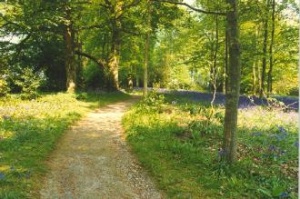
As I continued I saw several more deer, poised like statues, silently waiting for me to pass so they could continue their grazing. All the while I kept saying, "this is the loveliest place I've ever seen!" But when I reached the village of Melbury Osmund I said, "no, this is the loveliest place I've ever seen!"
Its cluster of thatched cottages is set on a southward facing slope that runs down to a stream and a ford. The cottages, some of them dating from the 17th century, are very well preserved but don't have that tarted up appearance so many modernized cottages have. They seemed to be just as Tess would have found them a hundred years ago. Each one more perfect than the next.
I rested on a bench in the graveyard at the church of St. Osmund before entering the village High Street with my little Minolta poised and ready.entering the village High Street with my little Minolta poised and ready. I was leaning over a garden gate to get a shot of one of the prettiest cottages when I heard and then saw a giant Alsatian. He was guarding his turf and let me know in no uncertain terms that I was intruding.
His mistress came out to see what the fuss was all about and instead of shooing me away, as she certainly would have been justified in doing, invited me into her garden, then disappeared into her cottage and returned a moment later with two cool drinks. We sat together under a giant horse chestnut tree and talked about life in her village. I think I would have changed places with her in a minute, if given half a chance.
I explored the village a while longer and then decided to skip lunch and head back to the Rectory House for a cream tea with home-made scones and some of the clotted Dorset cream I had become addicted to while travelling in Dorset.
The walk back was just as pleasant as the journey going; it wasn't too tiring because it was mostly over level ground on a paved country road. There was an occasional car but, for the most part, I had this beautiful fairyland all to myself.
My third day in Evershot was another near-perfect day, thanks to the country buses. It was Thursday, the day the Pearce, Darch & Willcox came through on its way to Sherborne. I felt just like a regular when I said "Good morning Alex" as I boarded at 9.42 a.m. in front of the school along with some village ladies on their way for a morning of shopping.
Note
The Southern National no. 212 has now taken over the Evershot route from the Pearce, Darch & Willcox company. The timetable is the same.
Alex gave me a big smile to let me know that he recognized me from our ride together from Dorchester to Evershot. We took an indirect route, which gave me an opportunity to see more appealing Dorset villages, and arrived in Sherborne an hour later.
Alex said he would be returning to Evershot at 12.40 p.m. but suggested that if I wasn't ready to come back that soon I could catch one of several buses going from Sherborne to Yeovil, a 15-minute ride, and leave from Yeovil on the 5.30 p.m., that would get me back to Evershot around 6.30 p.m. This was a good idea because I intended to scout around Sherborne to see if I wanted to return to spend the three days I had left open in my schedule.
As soon as we arrived in Sherborne I knew a few hours wouldn't be enough. This is one of England's most beautiful yet least publicized ancient towns. As I walked down Cheap Street I was impressed with the quality of the shops. I passed medieval, Tudor, and Georgian buildings, many with bow windows and timber framing.
I soon came to the entrance of Swan Yard, a little shopping precinct which has been converted from stables. It was lined with antique and craft -lions. I bought a leaflet called "Town Walk" that told me about the literary associations of many of Sherborne's buildings.
I had already seen one cluster of buildings in great detail at home in California -the Sherborne School. It was used as a setting for the Peter O'Toole version of Goodbye Mr. Chips. I fully expected Chips in his flowing robes to come dashing through the gates.
And then, as I threaded my way between the twists and turns of this pleasing town, I caught sight of the great abbey church which is the centrepiece of Sherborne. Its stonework, which had recently been washed and restored, seemed to glow in the afternoon sunlight. I needed no tour guide to tell me that this is one of the handsomest churches in England. Its interior has some of the finest fan vaulting in the country.
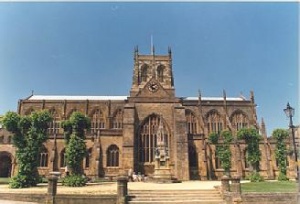
Sherborne
When I boarded the bus that morning I had no idea what I was going to find in Sherborne. I didn't know about the abbey or the two castles, one erected in the 7th century standing in ruins on a romantic, windswept sight; the other, the 'new castle', begun by Sir Walter Raleigh in 1594, stands in a park landscaped by Capability Brown. It is full of treasures from four centuries.
Finding these delightful surprises on my own made my way of travelling much more fun than the conventional way with a planned itinerary. Imagine turning a corner and suddenly being taken by surprise by a romantic castle given to Raleigh by Elizabeth I!
I found a charming hotel, the Half Moon, and booked for a three-day stay starting the next day. I left Sherborne knowing that my return visit would be fascinating. On my short ride to Yeovil, my companion on the seat across from me was a long-haired Dachshund.
Dogs are allowed to ride the country buses as long as they behave themselves and pay their fare. This one ran, on and saved a window seat while his master paid for both of them. He was a gentleman with impeccable manners - his master was nice too.
I only had half an hour in Yeovil before catching the last bus back to Evershot, but I could tell it would be a nice town to live in; not as beautiful nor as romantic as Sherborne but charming in its own way. It had a large outdoor shopping mall with baskets brimming over with flowers; there was a department store and several supermarkets - the kind of place families come to do their serious shopping.
The ride back took us through Ryme Intrinseca, Yetminster, Leigh, Holywell, and my favourite, Melbury Osmund. This is a rural route, far from any motorway with lovely peaceful scenes - brown hens scratching in an orchard, creeper-covered inns, and old cottages half-hidden behind fruit blossoms.
This time of year it stayed light until after 9 o'clock so there was no hurry to get back, except that I didn't want to miss one of Chris Walden's delicious dinners. The bus pulled up at 6.45 and I had just enough time to change for it.
The next morning, after breakfast, I called a taxi from Sherborne. There wouldn't be another bus to Sherborne until next week. The ride took less than fifteen minutes and cost less than a car rental for a day, but it wasn't as much fun as the bus the day before. The driver delivered me safely to the Half Moon and by 10.30 1 was unpacked and ready to start another adventure, more convinced than ever that Thomas Hardy was right. It is better to know a little bit of the world remarkably well.
Note:
Angela Carpenter now runs Rectory House instead of Chris Walford. Rectory House was very nice when Chris Walford ran it but it's even nicer now and one of my favorite B&Bs. Angela has become a good friend.
This article first appeared in Dorset Life magazine.
Also by Joanne Paul
A Three Day Slice of English Country Life
Exploring Dorset by Country Bus | A Dorset Duck Pond
